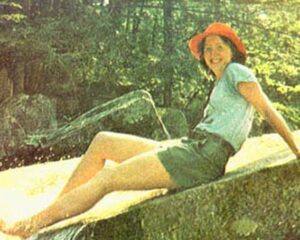When Shari Lynn Roth left her apartment in North Conway, New Hampshire for a short afternoon hike to one of her favorite spots among the White Mountain National Forest, what should’ve been a peaceful retreat turned into a fateful encounter with a still unknown predator.
Several theories have been floated since that August afternoon in 1977, but none have proven to be the truth about what happened more than four decades ago.
If you have information about the murder of Shari Lynn Roth, or about the cases of Jaclyn Snyder and Catherine Millican also discussed in this episode, please contact the New Hampshire Cold Case Unit at (603) 271-2663, by email coldcaseunit@dos.nh.gov, or leave a tip via the Cold Case Unit Tip form.
August 21, 1977
It was Sunday afternoon, August 21, 1977, and 22-year old Shari Lynn Roth had just left the apartment she shared with two roommates in North Conway, New Hampshire, setting off for a short solo hike in the White Mountain National Forest.
According to Greg Melville’s reporting for the New Hampshire Union Leader, Shari had only lived in the Mt. Washington Valley area for about nine months, but she immersed herself in everything the region had to offer – the hiking, skiing, biking, canoeing, and other outdoor adventures – while also doing what she could to strengthen the community she was part of. Shari had a heart for service and had dedicated her young adult life to helping others.
She grew up in Massachusetts and graduated from Lincoln-Sudbury Regional High School and then went on to study at the University of Massachusetts at Amherst. During her college years, she volunteered as a counselor working with women in a Massachusetts prison. Joanne Derbort writes for the Middlesex News that one of the women Shari got to know at the prison was pregnant, and Shari volunteered to take care of the woman’s child once she gave birth until she was released. Shari’s parents did not agree with the idea, so Shari instead helped to find someone else who could care for the woman’s baby, and then helped that same woman attend college following the completion of her sentence. According to Derbort’s reporting, the woman named her baby Shari.
It was no surprise that Shari planned to continue on this path of service to others as a career. First though, after graduating from UMass, she fueled her adventurous spirit with an opportunity working out west at the Olympic National Park in Washington State for the summer. She moved back to New England once the season was over during the late fall of 1976.
In December of that year, a person by the same name put a classified ad in the Mt. Washington Valley Mountain Ear paper. It read, “WANTED: Would like to share a house or apt. With others involved with art, music, photography, etc. Please call Shari Roth.” Shari eventually found a place with two other women in North Conway.
Shari worked a few gigs waiting tables and then a job in a factory when she first came to the Valley, but she was eager to return to counseling. She was the first to apply for an open position at the Mt. Washington Valley Women’s Health Clinic and quickly landed the job. She soon became the full time director for the clinic. Not stopping there, Shari and some friends also opened a drop in clinic for kids and teens in the area and hoped to start a task force to help survivors of sexual assault and domestic violence.
It was clear that Shari was passionate about helping others through counseling, both as a professional in the field and as a friend. Everyone who spoke about Shari told of some sort of selfless act of kindness she showed them. She was the listening ear that people turned to for advice. Shari was level headed and compassionate and supportive.
Shari’s other passions included photography and being in nature. During the summer of 1977, she was in the process of training an assistant to lighten her workload, but in the rare moments when she wasn’t working with clients or counseling kids, Shari loved to hike, with friends and solo, and she often brought her camera along to capture the stunning landscape that is the White Mountain National Forest.
The rugged, expansive wilderness of the White Mountain National Forest makes up the heart of New Hampshire. Managed with care by the guardians of the forest, the U.S. Forest Service, this breathtaking sanctuary stands as a testament to the beauty and resilience of nature. Towering peaks pierce the sky, their snow-capped summits veiled in mist, while lush forests blanket the valleys below with pines, hemlocks, and spruces lining up around cascading waterfalls and hidden gorges as if the trees themselves are ready to dive in for a swim.
That August afternoon when she left her apartment, Shari was heading to Sawyer Pond, a small body of water nestled within the White Mountain National Forest. The picturesque destination offers serene natural beauty and tranquil surroundings, and it’s a popular spot for hikers, swimmers, nature enthusiasts, and photographers. Hiking along the Sawyer Pond Trail, Shari would have meandered through a dense forest of towering trees with occasional glimpses of the surrounding mountains and valleys. The just over 3 mile trail follows a gentle incline, gradually leading towards the calm waters of Sawyer Pond.
The Search & Discovery
It’s a relatively unchallenging hike, meaning that a skilled and confident hiker like Shari should’ve returned home after a few hours, at most. She was scheduled to volunteer at the drop in clinic at 7 p.m. Sunday night and it’s not something she would’ve missed. But as the sun sank lower in the sky and Shari failed to return, her roommates got more and more nervous.
Even the most picturesque of places like the White Mountain National Forest can get dangerous after dark. With dense tree coverage and little light in such a rural area, the forest is almost pitch black. Trails typically easy to navigate during the day become confusing labyrinths, and then the predators come out.
Gloria Poloquin and Greg Melville report for the New Hampshire Union Leader that one of Shari’s roommates contacted local Conway Police that same night to report that she hadn’t made it back from her hike. Police issued an “attempt to locate” and New Hampshire State Police were also notified to be on the lookout for a 5-foot-8 woman with short brown hair and blue eyes, as well as her vehicle, a SAAB.
Reports vary here, but sometime in the next three days, possibly the very next day, Monday, a State Police trooper found Shari’s car in a parking lot in Livermore off Route 302 near one entrance to the Sawyer Pond Trailhead. A volunteer search party of about 50 people accompanied officials from the Carroll County Sheriff’s Office, the U.S. Forest Service, N.H. Fish and Game, and the local North Conway Rescue squad into the woods surrounding that parking lot and the popular hiking trail.
The first two days of searching were fruitless, but the third day revealed a heartbreaking discovery not far from the well-worn path to Sawyer Pond.
Shari’s nude body was found by a volunteer searcher around 12:30 p.m. on Wednesday, August 24. She was laying only 40 or 50 feet from the trail near the halfway point to the pond. It was clear that Shari’s death was the result of a homicide.
The autopsy found that Shari died as the result of asphyxiation due to strangulation and was likely killed in the same place she was found sometime in the afternoon on Sunday, the day she left for her hike. There was also evidence to suggest Shari was sexually assaulted, but investigators would not or could not confirm this detail at the time. And though investigators said they were searching the location surrounding her body and carefully examining the area for any clues, police didn’t elaborate on what other evidence, if any, was found at the scene. I don’t know if her clothing was still at the scene either.
With her body exposed to the elements for several days, it meant that vulnerable evidence was likely already degraded. Any potential witnesses in the area during those few days were long gone. But nevertheless, the investigation into Shari’s murder began with an urgency. Locals wanted to know their mountain home was safe, while hikers and other visitors hoped they’d soon feel confident venturing out on the trails alone once again.
Early Investigation
Shari’s car, which had been impounded since the state trooper found it in the trailhead parking lot, was analyzed for prints and other potential evidence. Meanwhile, investigators asked that anyone who was in the area of the Kancamagus Highway between that past Saturday, August 20 and the day she was found, Wednesday the 24th, to contact New Hampshire State Police. No detail was considered inconsequential.
The response to that public appeal was strong, according to the Attorney General’s Office, yet nothing solid had developed from the calls that came in during that first week of the investigation. By September 7 though, police had a more specific request for information. The Union Leader reports that the Attorney General’s office was hoping to speak to the occupants of a red Volkswagen Beetle with New Hampshire plates seen parked near the Sawyer Pond Trail around 5 p.m. on Sunday, August 21, the day Shari was believed to be murdered. The people in the VW “Bug” were not suspects, but investigators believed they could have critical info that could be helpful to the case.
That search for the red Volkswagen and its occupants continued for a few weeks, but a month after Shari’s murder, investigators still hadn’t located the car owner or anyone else connected to it. A September 21st piece in The Reporter newspaper indicates that the Attorney General’s office was reviewing, or planning to review, the thousands of red VW Beetle’s registered in the state, but it would take a while to run through the list. In the meantime, investigators were still hoping someone would come forward to share what they saw or heard on the day Shari was killed.
Other than asking the public for help and actively searching for the owner and occupants of that red car, details regarding the investigative efforts in Shari’s case are scarce. All the AG’s office and State Police would say was that Shari’s case remained active. However, it seems the resources dedicated to her investigation were taxed or at least divided in some way, because New Hampshire State Police were in the midst of yet another homicide of a young woman about 100 miles south in Lee.
This story continues on Dark Downeast. Press play to hear the full episode wherever you get your podcasts.
Episode Source Material
- Wanted Ad, The Mt. Washington Valley Mountain Ear, 24 Dec 1976
- Woman’s nude body found by Gloria Poloquin and Greg Melville, Union Leader, 25 Aug 1977
- Shari Roth strangled; hikers’ reports asked, Union Leader, 26 Aug 1977
- Shari Roth funeral services announcement, Boston Globe, 26 Aug 1977
- Slain Shari liked by all who met her by Greg Melville, Union Leader, 28 Aug 1977
- Shari case response ‘great’ by Gloria Poliquin, Union Leader, 30 Aug 1977
- Murder victim found on trail following intensive search, The Reporter, 31 Aug 1977
- Comments, The Reporter, 31 Aug 1977
- Witnesses sought in strangling, Union Leader, 07 Sep 1977
- Missing woman, 22, found slain in Lee by Ellie Kniager and Bill St. Laurent, Union Leader, 15 Sep 1977
- Red car still sought by police in Sawyer Pond murder of girl, The Reporter, 21 Sep 1977
- Hiker dies of exposure by Janet Hounsell, The Reporter, 28 Sep 1977
- Getting away with murder by Barbara Strauch, Union Leader, 11 Dec 1977
- Untitled article, The Mt. Washington Valley Mountain Ear, 23 Dec 1977
- Friends don’t forget Shari Roth’s ideas by Joanne Derbort, Middlesex News, Aug 1978
- Murder probe, Union Leader, 14 Jan 1979
- Murder suspect Christopher Wilder dead as police move into arrest, UPI, 13 Apr 1984
- Suspect in abductions is shot dead, AP via New York Times, 14 Apr 1984
- Slayer leaves NH woman $1/4M by Gloria Poliquin, Union Leader, 21 Apr 1984
- Police trace Wilder’s path by Roger Talbot, Union Leader, 22 Apr 1984
- Police probe Wilder link to 3 NH slayings by Gloria Poliquin, Union Leader, 24 Apr 1984
- Police trading information on Wilder’s spree, Union Leader, 3 Jun 1984
- Calif. Police believe death linked to Wilder, Union Leader, 17 Jun 1984
- Unsolved murders baffle police by Lyda Phillips, UPI via Union Leader, 19 Aug 1984
- Most hikers safe, but common sense urged by Lorna Colquhoun, Union Leader, 05 Jun 1996
- Hikers share trail with murder investigators, AP via Athol Daily News, 28 Nov 2001
- Two slain women, no answers by Lorna Colquhoun, Union Leader, 04 Apr 2002
- Police have leads but not much else by Charles Stein, Concord Monitor, 17 Nov 1978
- ‘We know nothing more now than we did then’ by Meg Burton, Concord Monitor, 18 Aug 1980
- Help asked in murder probe, AP via Greenfield Recorder, 13 Nov 1978
- Girl visiting Port City missing since Sept. 4 by Barbara Strauch, Union Leader, 14 Sep 1977
- Father expresses anger and sorry over daughter’s death by Barbara Strauch, Union Leader, 16 Sep 1977
- Portsmouth clues probed in death of Spokane girl by Barbara Strauch, Union Leader, 20 Sep 1977
- Washington woman’s death still mystery, Union Leader, 27 Sep 1977
- State offered $2500 to post as reward by Donn Tibbetts, Union Leader, 23 Mar 1978
- Woman’s death ruled homicide, Union Leader, 27 Oct 1978



